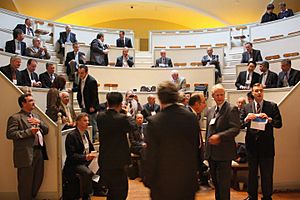Gazi Yaşargil facts for kids
Quick facts for kids
Mahmut Gazi Yaşargil
|
|
|---|---|
| Born | 6 July 1925 Lice, Diyarbakır, Turkey
|
| Died | 10 June 2025 (aged 99) |
| Education | Ankara University University of Jena Basel University |
| Years active | Surgical field (1950–2009) Professor of Neurosurgical Anatomy (1950–?) |
| Known for | Founding of Microneurosurgery |
| Medical career | |
| Profession | Neurosurgeon |
| Institutions | University of Vermont University of Zurich University of Arkansas for Medical Sciences Istanbul University |
| Sub-specialties | Neurosurgery Microneurosurgery Neuroanatomy |
| Research | Microvascular surgery Cerebrovascular disease |
| Awards | Marcel Benoist Prize (1975) State Medal of Distinguished Service (2000) |
Mahmut Gazi Yaşargil (born July 6, 1925, died June 10, 2025) was a very important Turkish-Swiss doctor. He was a neurosurgeon, which means he was a surgeon who specialized in operations on the brain and nervous system. He helped create a new way of doing brain surgery called microneurosurgery. This method uses tiny tools and microscopes to perform delicate operations.
Dr. Yaşargil used his own special tools to treat serious conditions like epilepsy and brain tumors. He worked at the University of Zurich in Switzerland for many years, from 1953 until he retired in 1993. In 1999, he was called "Neurosurgery’s Man of the Century" for his amazing contributions. He also helped start the Eurasian Academy.
Contents
Early Life and Education
Yaşargil was born in Lice, Turkey. He studied at Ankara Atatürk Lisesi and Ankara University in Turkey. Later, he went to Germany to study medicine at the Friedrich Schiller University of Jena. In 1945, he moved to the University of Basel in Switzerland, where he earned his doctorate degree in 1950.
Developing Microneurosurgery
Dr. Yaşargil was a genius at developing new surgical methods. He created special microsurgical techniques for brain surgery, especially for problems with blood vessels in the brain. Before his work, many of these conditions were impossible to operate on. His new methods completely changed how doctors could help patients.
In 1969, Yaşargil became an associate professor at the University of Zurich. By 1973, he was the main professor and chairman of the Neurosurgery Department. Over the next 20 years, he performed about 7,500 brain operations in Zurich using his micro-techniques. He retired from this position in 1993.
After retiring from Zurich, in 1994, Dr. Yaşargil became a professor at the University of Arkansas for Medical Sciences in Little Rock. There, he continued to practice micro-neurosurgery, do research, and teach new doctors.
Legacy and Influence
Many people consider Yaşargil to be one of the greatest neurosurgeons of the 20th century, alongside Harvey Cushing. He trained around 3,000 doctors from all over the world in his special micro-neurosurgical lab in Zurich. These doctors learned his techniques and took them back to their own countries.
Dr. Yaşargil also attended hundreds of medical meetings and conferences. He was often invited as a special guest to share his knowledge. His wife, Dianne Bader-Gibson Yaşargil, was a nurse who worked by his side in the operating room since 1973.
Yaşargil passed away on June 10, 2025, at the age of 99, at his home in Stäfa, Switzerland.
Awards and Recognition
- Marcel Benoist Prize (1975)
- State Medal of Distinguished Service (2000)
See also
 In Spanish: Gazi Yaşargil para niños
In Spanish: Gazi Yaşargil para niños


